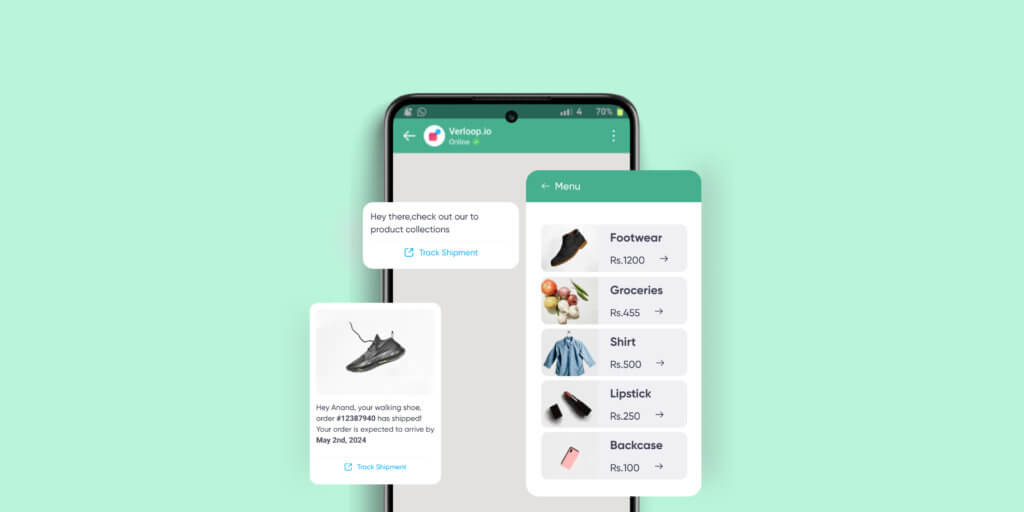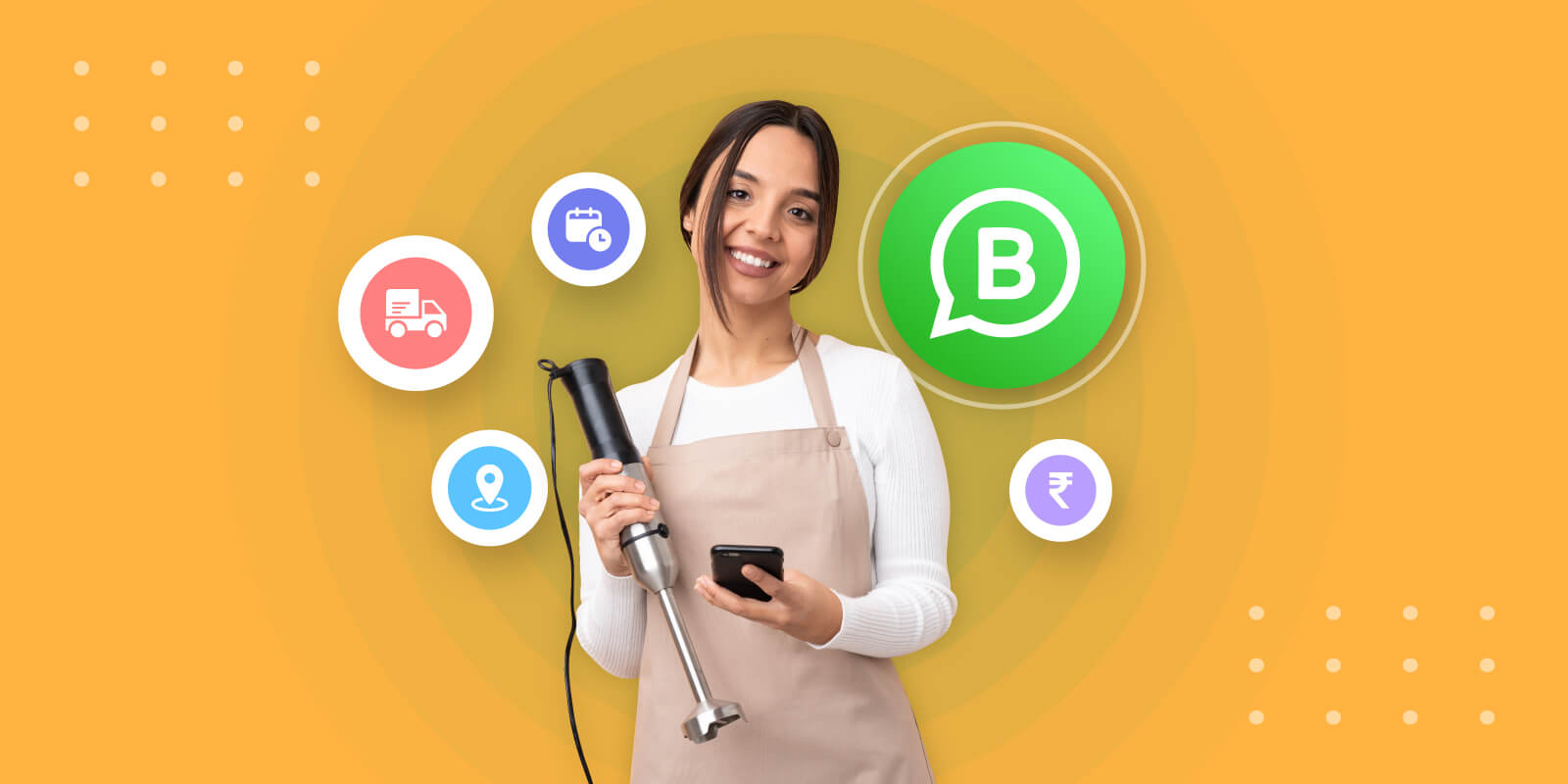Unlocking Growth: The Ultimate Guide to Implementing WhatsApp Chatbots for eCommerce

Unlocking Growth: The Ultimate Guide to Implementing WhatsApp Chatbots for eCommerce
We are undoubtedly in a competitive digital market, and standing out demands creativity to improve client retention and sales conversion. With the growing desire for fast support and tailored interactions, WhatsApp chatbots are establishing themselves as a strong tool for organisations looking to improve their customer care capabilities. These virtual assistants with artificial intelligence are changing how eCommerce businesses communicate with their consumers by providing 24/7 assistance, personalised suggestions, and frictionless transaction experiences.
In this article, we’ll look at the several advantages of using WhatsApp chatbots within eCommerce and practical techniques for using them to generate development and success.
Suggested reading – WhatsApp Chatbot for Business
Top 12 Use Cases of WhatsApp Chatbots for eCommerce

1. Product Search and Recommendations:
WhatsApp chatbots specialise in helping customers locate the correct products by making specific suggestions based on their tastes and previous purchases. Furthermore, they can swiftly answer product-related questions, allowing users to make informed purchasing decisions.

2. Order Tracking and Updates
One of the primary benefits of WhatsApp chatbots is that they offer immediate details on the status of an order, shipment information, and delivery estimates. This proactive strategy promotes visibility and keeps customers updated throughout the buying process.
3. Shopping Cart and Checkout
Creating an efficient checkout process is critical for lowering cart abandonment rates. WhatsApp chatbots simplify the procedure by letting customers place orders instantly using the chat interface, reducing friction and improving the user experience.

4. Post-Purchase Support
Responding quickly and efficiently to returns, exchanges, and additional customer service requests is critical for establishing trust and loyalty. WhatsApp chatbots are capable of automating these steps, allowing for smooth post-purchase support and increased customer satisfaction.

5. Personalised Promotions and Offers
WhatsApp chatbots are capable of sending tailored messages of promotions and offers based on consumer data as well as purchase history, encouraging repeat business. Businesses may increase consumer engagement and sales by providing individualised recommendations.
6. Abandoned Cart Recovery
Abandonment of shopping carts is a major issue for eCommerce firms. WhatsApp chatbots may regain the interest of users who have left things in their carts by providing timely reminders and rewards, thereby recovering possibly lost purchases.

Suggested watching – WhatsApp Chatbots – An Even More Complete Guide
7. Customer Feedback and Reviews
Customer feedback is extremely valuable for developing products and services. WhatsApp chatbots can help with this process by gathering feedback while inviting customers to submit reviews, promoting a culture of continual improvement.

8. Promotional Campaigns and Announcements
Running targeted campaigns while interacting directly with customers about product releases or upgrades can have a major impact on brand awareness and engagement. WhatsApp chatbots allow businesses to reach their target audience directly and increase engagement through personalised messages.
9. Building Brand Loyalty
Setting up a personalised and engaging communication channel for consumers serves as essential for increasing brand loyalty. WhatsApp chatbots enable businesses to communicate with their audiences in a meaningful manner, resulting in better relationships and loyalty to a brand.
10. Integration with eCommerce platforms
WhatsApp chatbots can interact smoothly with pre-existing eCommerce platforms, delivering a consistent customer experience across all channels. This integration promotes a smooth exchange of information and improves productivity, resulting in increased business growth.
11. Order confirmation
WhatsApp chatbot automation expedites order confirmation in e-commerce, promptly notifying customers of successful transactions, thereby ensuring efficient communication and enhancing customer satisfaction through instant updates.
12. Product back-in-stock
Automation of WhatsApp chatbot notifies customers immediately when previously out-of-stock products become available again, facilitating timely purchases and improving user experience, thus driving sales and fostering customer loyalty in the e-commerce sector.
Ready to learn about the endless possibilities of WhatsApp chatbots?
Take advantage of our free trial and demo!
Success Stories
- Sirona, in collaboration with Verloop.io, provides a period tracking service via WhatsApp, enhancing brand awareness, customer acquisition, and engagement. Through their chatbot, users can easily initiate conversations, seamlessly integrating Sirona into the consumer journey. This enables timely notifications, leveraging fun trivia, insightful blogs, and product offers to stimulate demand effectively.
- Cairocart, an integrated electronics store in Egypt, struggled with managing customer queries due to a high-density customer base. To tackle this challenge, they adopted Verloop.io’s conversational AI solution across platforms like WhatsApp, Instagram, Website, and Facebook. Automating personalised responses to over 50,000 repetitive queries, the solution provided substantial relief to the support team.
Explore the case study further at: https://www.verloop.io/case-studies/cairocart/
- Ninjacart, with a vast network of stakeholders, relies on WhatsApp for outreach, promotions, and brand awareness. However, managing a surge in diverse queries strained their customer service. To streamline operations, they adopted Verloop.io’s Co-pilot for support, leveraging AI features like rephrasing messages, tone adjustment, expansion, and summarization. These enhancements saved time, boosted productivity, and facilitated performance auditing, as praised by Alok Sulakhe, Team Lead at Ninjacart.
These can be considered merely a few illustrations of how eCommerce companies are leveraging WhatsApp chatbots to accomplish substantial outcomes.
Suggested reading – WhatsApp Business API Pricing Model EXPLAINED (2024)
Getting Started
Utilising a WhatsApp chatbot for your eCommerce business is a simpler task than you might think. Here’s how.
- Research and compare several BSPs (Business Service Providers) based on your requirements, budget, and technical skills. Verloop.io, Wati.io, and Zendesk Chat are among the most popular solutions.
- Give your preferred platform the required details and training data, such as product descriptions, FAQs, and customer support scripts.
- Set key performance indicators, or KPIs, to assess the productivity of the WhatsApp chatbot, which includes a rate of conversion, client retention scores, and response times. Verloop.io’s analytics dashboard provides real-time information on WhatsApp chatbot performance, allowing you to optimise your strategy and drive continuous development.
Verloop.io’s smart WhatsApp chatbot solution has a simple interface, robust automation abilities, and easy integration with popular eCommerce platforms. Our team of professionals can assist you in creating a chatbot that is tailored to your specific business requirements and objectives.
Do not wait any longer! Consult with Verloop.io to see the ways a WhatsApp chatbot could assist your eCommerce business expand and reach new heights of consumer engagement and revenue.
In the extremely dynamic area of digital commerce, utilising new solutions is critical for organisations to succeed. WhatsApp chatbots offer a huge new opportunity in client interactions, boosting eCommerce growth. These AI-powered assistants take customer service to new heights by offering 24-hour help, tailored suggestions, and smooth transaction experiences.
The benefits of incorporating WhatsApp chatbots into online store operations are many. From speeding product searches and improving post-purchase support to increasing customer loyalty and restoring abandoned carts, chatbots like these provide a wide range of features that translate into meaningful business results.
Real-world success examples from industry giants such as Myntra, Sephora, and Macy’s demonstrate WhatsApp chatbots’ transformative potential for boosting client retention and revenue growth. Furthermore, their ease of setup and connectivity with existing eCommerce systems make them suitable for enterprises of all sizes.
As we negotiate the constantly shifting internet, utilising WhatsApp chatbots becomes a strategic essential for eCommerce businesses seeking long-term growth and differentiation. WhatsApp eCommerce chatbots usher in a new era of digital customer interaction and corporate success by providing personalised experiences and streamlining operations.
FAQ on WhatsApp Chatbot for eCommerce
1. Are WhatsApp Chatbots free?
WhatsApp Chatbots built on WhatsApp Business API have a small installation fee associated with them. This includes hosting, installation, and integration charges. For WhatsApp Cloud API, there are no hosting fees as Meta hosts them on their servers. In addition to this, you have to pay per conversation too. The amount changes depending on who initiated the chat and from which country.
2. What are the prices of eCommerce WhatsApp Chatbots?
There is no additional cost for an eCommerce WhatsApp chatbot. It’s the same as a regular chatbot for WhatsApp. Chatbots built on WhatsApp Business API have a small installation fee associated with it for hosting, installation, and integration. Cloud API users don’t have hosting fees as Meta hosts them on their servers. In addition to the installation fee, eCommerce businesses have to pay per conversation too. The amount changes depending on who initiated the chat and from which country.
3. Is eCommerce Chatbot and Shopping Chatbot the Same?
Yes, eCommerce chatbots and shopping chatbots are the same and both the terms are used interchangeably. These chatbots automate a user’s end-to-end buying journey to provide a seamless customer experience.
4. What All Platforms Do WhatsApp Support for eCommerce integration?
eCommerce integrations on WhatsApp will help you streamline your communication and reduce tasks on your human resources across departments. You can integrate your WhatsApp chatbot with your eCommerce store, CRM and ERP tools, ticketing platforms, payment gateways, and loyalty programs. Know how this help provides a seamless experience for your customers here.
5. Can I Get an eCommerce WhatsApp Chatbot Demo?
Yes, you can see how the eCommerce WhatsApp chatbot works with Verloop.io. Talk to our experts by scheduling a demo with them.
To sum up, this is how WhatsApp Chatbot will benefit the company and the customers –
- They help increase revenue by generating highly qualified leads.
- Chatbots reduce support costs by automating low-level queries.
- eCommerce Chatbots are easier to use than traditional alternatives, for agents and customers alike.
- They’re a quicker means of communication.
- Chats create a human connection, unlike emails and SMS.
- eCommerce Chatbots help improve CSAT and overall customer experience.






